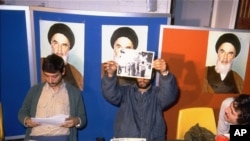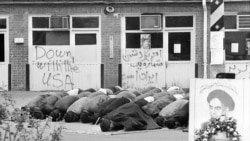I drove past the chancellery on November 4, 1979 and entered Takht-e Jamshid Avenue. One of the modern streets of Tehran where I could get hold of the latest books and publications from the United States and Europe, and call on a few tobacconists who sold quality cigarettes and tobacco, even some nine months after a revolution that had changed the streets among other things.
It was a gloomy cloudy morning and I decided to turn left and go to Bahar Avenue for the city's finest coffee at Hasmik's before driving north in my canary yellow Iranian made Paykan.
Like everything else, Hasmik's little coffee shop had lost nearly all of its pre-revolution glamour. It was dark and Hasmik had forgotten her welcoming smile for months. Most of her family had already left Iran.
I liked the boxes behind the counter with a picture of a handshake. On one sleeve there was a star-spangled flag of the United States and the other hand came out of a sleeve with a picture of the lion and sun on the Iranian flag. A relic of President Harry Truman's aid to the developing Iran of the 1950s within the frameworks of his Point Four Program.
I had tasted skimmed milk at school for the first time in the small town of Delijan on the road from Tehran to Isfahan in 1958. Pictures of the proud handshake were almost everywhere at that time, hospitals, agricultural development centers, schools, public offices, everywhere.
In my childhood, America was Iran's closest friend and ally. Everything good must have come from America. Everyone preferred a U.S. made car to any other vehicle. The best hospitals, universities, schools had something to do with America. Most doctors and university professors were trained in America and there were long lines outside the U.S. consulate where more young men and women were waiting for their visa to go to a school in America.
There were some 40,000 Americans living in Iran and around the same number, or maybe more, Iranians were in the United States.
I drank Hasmik's magnificent coffee, made a note in my diary to send her a nice Christmas card before the 6th of January, that is Armenian Christmas in Iran, and drove north to catch up with friends at the Iran America Society in the affluent Vozara Avenue. The society, another beacon of friendship between Iran and the United States had two buildings, one on Vozara and another near the University of Tehran.
The IAS was a venue for learning English, accessing the latest books including textbooks from America at the Abraham Lincoln Library, sitting for tests administered by the Fulbright Commission for those who wanted to study advanced medicine in America.
Meanwhile, it offered performances by the finest of American and Iranian musicians and held exhibitions of paintings and sculpture in its two large galleries, Pope and Ala, named after A U.S. historian who was an expert in Iranian history and archaeology, and an Iranian ambassador to Washington who had served both nations many years ago.
It also had a movie theatre where I used to watch the finest American movies in original English audio and where Iranian and American stage actors presented their plays.
It was there at the Iran American Society that I learned about the attack on the embassy. Everyone, Iranian or American, was deeply shocked by the news of the seizure of the embassy. Yet everyone was hopeful that is was going to pass. Doesn't everything else pass? But this time It took so long and turned so bitter and ugly.
More than 50 U.S. diplomats were held hostage for 444 days and the hostage takers rose to positions of power many years later, enjoying privileges one could enjoy only as a result of a depressing discrimination against others. Some of them admitted later that what they did was not meant to be as bad and embarrassing and damaging as it turned out to be later. Every year on this day, some of the hostage-takers remember to criticize what they did, but none has ever sincerely apologized and admitted the gravity of their action.
Today, it is another 4th of November. Some 2733 miles, one revolution, a war and a massive economic crisis away, it is again a dark gloomy day. The news of the day, on November 4, 2019, is about a plan to include a few chapters in Iran's elementary and high school textbooks about "America's crimes" in Iran. I think of the picture on the box at Hasmik's and say, does anyone in Tehran ask himself how far this sinister grudge, this banal demonization is going to go?







